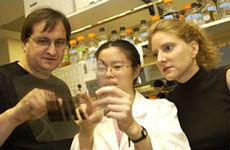Paul Herman
Contact Information
Professor
Areas of Expertise
- Cell Signaling
- Protein Homeostasis
- Cellular Compartmentalization
Keywords: Growth control; Ras proteins; Cancer; cAMP-dependent protein kinase (PKA); Protein phosphorylation; Signal transduction; Stationary phase; P bodies; Ribonucleoprotein (RNP) complexes.
RESEARCH INTERESTS: The regulation of quiescence
Our lab is interested in understanding the mechanisms  controlling eukaryotic cell growth and proliferation. Our primary focus has been on the G₀-like resting states that cells enter when conditions are not conducive to continued growth. The transitions between active division and these periods of quiescence are known to be key points of proliferative control. We are interested in characterizing the signaling pathways that control these transitions and the processes required for the maintenance of cell viability in the absence of division. The long-term goals of this work are to develop a more complete understanding of the general control of cell proliferation and to identify novel targets for the treatment of proliferative disorders, including human cancers. More information about our research can be found by visiting our lab web site (see below for link).
controlling eukaryotic cell growth and proliferation. Our primary focus has been on the G₀-like resting states that cells enter when conditions are not conducive to continued growth. The transitions between active division and these periods of quiescence are known to be key points of proliferative control. We are interested in characterizing the signaling pathways that control these transitions and the processes required for the maintenance of cell viability in the absence of division. The long-term goals of this work are to develop a more complete understanding of the general control of cell proliferation and to identify novel targets for the treatment of proliferative disorders, including human cancers. More information about our research can be found by visiting our lab web site (see below for link).
Please see the Herman Lab Website for more information
Recent Publications (since 2009)
-
Shah, K. H. , B. Zhang, V. Ramachandran and P. K. Herman. (2012) Processing body and stress granule assembly occur by independent and differentially regulated pathways in S. cerevisiae. Genetics, In press.
-
Mousley, C. M., P. Yuan, N. A. Gaur, K. D. Trettin, A. H. Nile, S. J. Deminoff, B. J. Dewar, M. Wolpert, J. M. Macdonald, P. K. Herman, A. G. Hinnebusch, and V. A. Bankaitis. (2012) A sterol-binding protein integrates endosomal lipid metabolism with TOR signaling and nitrogen sensing. Cell 148: 702-715.
-
Klionsky et al., (2012) Guidelines for the use and interpretation of assays for monitoring autophagy. Autophagy 8: 445-544.
-
Ramachandran, V., K. H. Shah and P. K. Herman. (2011) The cAMP-dependent protein kinase signaling pathway is a key regulator of P-body foci formation. Molecular Cell 43: 973-981.
-
Yeh, Y.-Y., K. H. Shah and P. K. Herman. (2011) An Atg13 protein-mediated self-association of the Atg1 protein kinase is important for the induction of autophagy. Journal of Biological Chemistry 286: 28931-28939.
-
Ramachandran, V. and P. K. Herman. (2011) Antagonistic interactions between the cAMP-dependent protein kinase and Tor signaling pathways modulate cell growth in Saccharomyces cerevisiae. Genetics 187: 441-454.
-
Yeh,Y.-Y, K. H. Shah, C.-C. Chou, H.-H. Hsiao, K. M. Wrasman, J. S. Stephan, D. Stamatakos, K.-H. Khoo and P. K. Herman. (2011) The identification and analysis of phosphorylation sites on the Atg1 protein kinase. Autophagy 7: 716-725.
-
Yeh, Y. Y., K. M. Wrasman and P. K. Herman. (2010) Autophosphorylation within the Atg1 activation loop is required for both kinase activity and the induction of autophagy. Genetics, 185: 871-882.
-
Stephan, J. S., Y.-Y. Yeh, V. Ramachandran, S. J. Deminoff and P. K. Herman. (2010) The Tor and cAMP-dependent protein kinase signaling pathways coordinately control autophagy in Saccharomyces cerevisiae. Autophagy 6: 294-295.
-
Stephan, J. S., Y.-Y. Yeh, V. Ramachandran, S. J. Deminoff and P. K. Herman. (2009) The Tor and PKA signaling pathways independently target the Atg1/Atg13 protein kinase complex to control autophagy. Proceedings of the National Academy of Sciences 106:17049-17054.
-
Deminoff, S. J., V. Ramachandran and P. K. Herman. (2009) Distal recognition sites in substrates are required for efficient phosphorylation by the cAMP-dependent protein kinase. Genetics, 182: 529-539.
